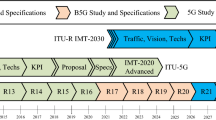Abstract
Device-to-Device (D2D) communications allow devices to communicate directly without going through infrastructure. It is considered a promising solution to improve communication performance and network capacity of LTE-Advanced system. In addition, the direct proximity communication implies reduced delay and energy consumption. However, from the perspective of D2D networks, co-existence of multiple D2D User Equipments (UEs) is a challenging issue because of the proximity interference management, especially, without a central controller in a distributed scheme. In this article, we propose a novel distributed power control and collision resolution schemes, which can enhance discovery success of proximity devices conforming to LTE-A networks. The simulation results demonstrate that our proposed schemes can significantly improve the performance of discovery success and detectable coverage by mitigating D2D interference.










Similar content being viewed by others
Notes
One RB consists of 12 subcarriers in the frequency domain.
References
Fodor G, Dahlman E, Parkvall S, Mildh G, Reider N, Miklos G, Turanyi Z (2012) Design aspects of network assisted device-to-device communications. IEEE Commun Mag 50(3):170–177
TR 3GPP 22.803 (2013) Feasibility study for Proximity Services (ProSe). ver. 12.0.0
TS 3GPP 22.278 (2014) Service requirements for the Evolved Packet System (EPS). ver. 13.0.0
TS 3GPP 23.303 (2014) Proximity-based services (ProSe). ver. 12.1.0
Shalmashi S, Miao G, Han Z, Slimane SB (2014) Interference constrained device-to-device communications. In: Proceedings IEEE ICC, Sydney
Lee N, Lin X, Andrews JG, Heath RW Jr Power control for D2D underlaid cellular networks: modeling, algorithms and analysis,” IEEE Selected Areas in Communications, vol. pp. [Online]. Available: arXiv:1305.6161
Fodor G, Reider N (2011) A distributed power control scheme for cellular network assisted D2D communications. In: Proceedings IEEE GLOBECOM, Houston
Phunchongharn P, Hossain E, Kim DI (2013) Resource allocation for device-to-device communications underlaying LTE-advanced networks. IEEE Wireless Magazine 20(4):91–100
Yu CH, Doppler K, Ribeiro CB, Tirkkonen O (2011) Resource sharing optimization for device-to-device communication underlaying cellular networks. IEEE Trans Wirel Commun 10(8):2752–2763
Kang HJ, Kang CG (2014) Moble device-to-device (D2D) content delivery networking: a design and optimization framework. J Commun Netw 16(5):568–577
Doppler K, Ribeiro CB, Kneckt J (2011) Advances in D2D communication: energy efficient service and device discovery radio. In: Proceedings of Wireless VITAE, Chennai
Hong J, Park S, Kim H, Choi S, Lee KB (2013) Analysis of device-to-device discovery and link setup in LTE networks. In: Proceedings of IEEE PIMRC, London
Hong J, Park S, Choi S (2014) Neighbor device-assisted beacon collision detection scheme for D2D discovery. In: Proceedings of IEEE ICTC, Busan
Park S, Choi S (2014) Expediting D2D discovery by using temporary discovery resource. In: Proceedings of IEEE GLOBECOM, Austin
Lin X, Andrews JG, Ghosh A, Ratasuk R (2014) An overview of 3GPP device-to-device proximity services. IEEE Commun Mag 52(4):40–48
3GPP TR 36.843 (2014) Study on LTE device to device proximity services radio aspects. ver. 12.0.1
Qualcomm (2013) 3GPP TSG RAN WG1 74, Techinques for D2D Discovery. R1-133600
Alcatel-Lucent Shanghai Bell (2014) 3GPP TSG RAN WG1 76, D2D discovery channel resource allocation. R1-140176
Samsung (2014) 3GPP TSG RAN WG1 76, resource allocation method for D2D discovery. R1-140393
3GPP TR 36.211 (2014) Evolved universal terrestrial radio access (E-UTRA); Physical channels and modulation. ver. 12.2.0
Baccelli F, Khude N, Laroia R, Li J, Richardson T, Shakkottai S, Tavildar S, Wu X (2012) On the design of device-to-device autonomous discovery. In: Proceedings of COMSNETS, Bangalore
Acknowledgments
This research was supported by LG Electronics Co. Ltd and the Brain Korea 21 Plus Project in 2015.
Author information
Authors and Affiliations
Corresponding author
Rights and permissions
About this article
Cite this article
Hong, J., Park, S. & Choi, S. Novel power control and collision resolution schemes for device-to-device discovery. Peer-to-Peer Netw. Appl. 9, 913–922 (2016). https://doi.org/10.1007/s12083-015-0375-6
Received:
Accepted:
Published:
Issue Date:
DOI: https://doi.org/10.1007/s12083-015-0375-6




